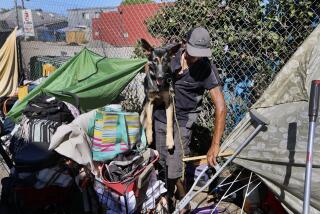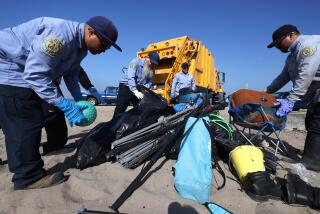When Beach Party Is Over, They Pitch In
- Share via
Greasy potato chip bags float in the water at the Hollywood Riviera in Torrance. A jagged-edged broken soda bottle pierces through the sand under the Hermosa Beach pier. A collection of cigarette butts lines the shore in Manhattan Beach.
It is Monday morning in the South Bay, and a nagging hangover besets beaches from San Pedro to Playa del Rey. An army of weekend sunbathers and picnickers has retreated inland for five days, leaving a blanket of trash and debris in its path.
“In the morning, I police the area in front of the tower and clear a corridor for myself,” said Dave Tedesco, a lifeguard near the pier in Hermosa Beach. “Most of the problems with lifeguards cutting their feet or getting hurt have to do with trash.”
The weekend rubbish toll on South Bay beaches can be brutal. As many as half a million people swarm to the beaches on a busy summer weekend, bringing with them hundreds of thousands of pounds of garbage.
While separate statistics for South Bay beaches are not available, maintenance workers for the Los Angeles County Department of Beaches and Harbors last year collected over 4,000 tons of garbage from its 31 miles of patrolled beaches, the department reports. About one quarter of those beaches are in the South Bay.
“I don’t think all the people who served in World War II could have picked up the mess left on our beaches on the fifth of July,” said Dick Gitlin, a spokesman for the department. Gitlin said holiday weekends, particularly long ones like this year’s four-day Fourth of July weekend, hit the beaches hardest.
Even with the volume of visitors and debris, county and local officials say that the trash and litter problem--albeit unsightly and annoying at times--is generally under control. Beaches today, they say, are no dirtier than they were five years ago, and some lifeguards--including Tedesco of Hermosa Beach--say they actually may be cleaner thanks to a myriad of cleanup programs.
With limited funds available for beach cleanup in the county, officials have looked to local communities, law enforcement agencies and private donations to assist the 60 full-time maintenance workers in keeping the trash, litter and vandalism manageable.
Volunteers
Last year, more than 3,400 people donated nearly 35,000 hours to the Department of Beaches and Harbors, according to Ken Johnson, who coordinates the volunteer programs for the department. Churches, real estate brokers, chambers of commerce, Boy Scouts, Girl Scouts and schoolchildren help coordinate cleanup programs or provide manpower for them, Johnson said.
The Redondo Beach Chamber of Commerce, for example, sponsors community sweeps of the beaches about three times a year. The program, most commonly identified by its mascot, “Sandy Seagull,” strives to involve as many city residents as possible in a one-day intensive combing of the Redondo beaches.
Ernie O’Dell, executive director of the Redondo chamber, said the program is designed more to educate beachgoers about beach etiquette than to collect large quantities of litter.
“It is a promotional thing to get people cognizant of not littering,” he said.
Litter Patrol
In Manhattan Beach, the Chamber of Commerce oversees a litter patrol that is funded by local businesses. About 10 high school students are paid to sweep the beaches for 20 hours a week during the summer. The city receives about $9,000 in donations each year to pay for the program, said Trudy Smart, manager of the chamber.
Some of the money for the Manhattan Beach program comes from RecyCAL, an organization of soft drink bottlers, beer distributors, grocers, recyclers and packaging companies around the state. RecyCAL also pays for a $60,000 county program that employs 25 students in the South Bay.
Under the RecyCAL program, teams of five workers comb the beaches on Fridays, Saturdays, Sundays and Mondays looking for the trash that county maintenance workers do not collect with their trucks. Gitlin, of the county Department of Beaches and Harbors, administers the program.
One team of students works at Dockweiler Beach, two at Hermosa Beach, one at Redondo Beach and one in Torrance. County officials do not provide Manhattan Beach with a team because of the chamber’s program there, Gitlin said. The teams began working in late June and will continue through the middle of next month.
Fills a Gap
The RecyCAL program is in its first year, but county officials are hoping that it will become permanent. Gitlin said sanitation employees project that RecyCAL workers will pick up at least 1 1/2 tons of litter this summer between Zuma and the Hollywood Riviera in Torrance. While that tonnage pales in comparison to the 4,000 tons county workers collect, Gitlin said the workers fill a gap in the cleanup routine.
“It complements our own maintenance and cleanup operation, which usually commences about 5 a.m.,” Gitlin said. He said the RecyCAL workers, who start at a later time, can get the litter that is discarded after the county workers make their sweep. “People lose sight of the fact that people come to the beach early in the morning and bring food and leave litter,” he said.
The South Bay Board of Realtors, a group that includes members from the three beach cities, has designated a weekend each of the past two years to help beautify buildings at the beach. The group does not pick up litter, but it cleans up the area in a different way.
About 125 workers from real estate offices this year painted the restrooms in the three cities and touched up the Manhattan Beach pier. Last year, they painted more than 30 lifeguard towers in the three cities.
Want Clean Beaches
“I live and work in Manhattan Beach, and I want to see a clean beach and see it looking good,” said Byron Rife, who organized the painting effort this year. “I know the lifeguards would like to work in nice towers, too.”
Not all of the beach litter crews are volunteers in the true sense of the word, though. In fact, the largest source of manpower for beach cleanup and maintenance programs is the county jail.
Lt. Charles Nipps, who oversees a work release program for the Los Angeles County Sheriff’s Department, said that about 30 people convicted of nonviolent crimes work the beaches on a typical summer day.
A typical work release participant spends about 10 weekends cleaning up the beaches, performing maintenance work and landscaping around parking lots, he said.
First Offenders
The participants are often first offenders who have been convicted of drunk driving or petty theft and who might lose their jobs if they were required to serve a jail term, Nipps said.
“We make them serve the first weekend in county jail so that they know what jail is all about,” he said. “Then we interview them. No one is forced to go and work. But most of them agree to it.”
Nipps said sheriff’s deputies make daily checks on the workers, who are admitted to the program only if they have less than 30 days to serve, have no record of violent crime in their immediate past, do not appear to be a danger to the community and have a stable home address.
“It is lots cheaper for the county,” Nipps said. “We save money by having them out of the jail and they are doing jobs that otherwise wouldn’t get done.”
Education, Prevention
County officials embrace the work release program and the other beach cleanup efforts as effective, but most beach regulars--particularly the lifeguards--say the key to keeping beaches clean is education and prevention.
As a preventive measure, lifeguards and local police officers make a point of asking beachgoers to use trash bins on the beaches and in parking lots. At Tedesco’s lifeguard tower in Hermosa, for example, a chalkboard posts warnings about riptides and surf conditions, but also advises sunbathers: “Please Pick Up Any Trash.” The message ends with a hand-drawn face with a large smile.
“Trash is a hindrance to any beach activity,” Tedesco said. “And people seem to be learning that.”
Beach patrol officers say they issue litter citations occasionally, although they spend more time tending to more serious problems such as drunkenness and fighting.
More to Read
Sign up for Essential California
The most important California stories and recommendations in your inbox every morning.
You may occasionally receive promotional content from the Los Angeles Times.













